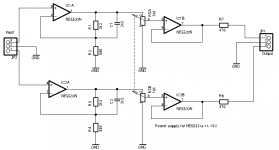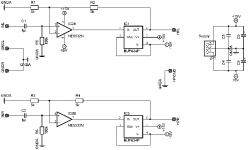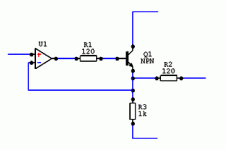Hello to everyone!
I just built up a very simple headphone amp with two NE5532. It works very well (and surprisingly loud!) and I just would like to know if I've made some cardinal faults in the schem, for example if I did some "Don'ts" or forgot some "Do's". Please have a look at the attached schem and tell me what You think about it. A little problem I have is the popping sound in the headphone when I turn on or off the power supply - especially when the positive and negative supply voltages don't raise or fall exactly at the same time. Does anyone know a good way to avoid this?
Any hints would be appreciated!
Greetings from Germany
Kai Markus Tegtmeier
I just built up a very simple headphone amp with two NE5532. It works very well (and surprisingly loud!) and I just would like to know if I've made some cardinal faults in the schem, for example if I did some "Don'ts" or forgot some "Do's". Please have a look at the attached schem and tell me what You think about it. A little problem I have is the popping sound in the headphone when I turn on or off the power supply - especially when the positive and negative supply voltages don't raise or fall exactly at the same time. Does anyone know a good way to avoid this?
Any hints would be appreciated!
Greetings from Germany
Kai Markus Tegtmeier
Attachments
I don't really see a need for the 470r output resistors.Try taking them out or using less resistance.You will find that output resistors can affect sound quality.The more you put the warmer the sound becomes.You can also try biasing the first stage into class a by a suitable resistor or fet cascode on the output to neg supply.A good buffer on the output such as buf 634 would probably sound better and punchier although they are a bit pricey but necessary with low impedance 16/32 ohm cans.
Yeah, Protos is right about the BUF634. NE5532 is a bipolar based opamp. That means it should be picky about input impedance and carefull impedance matching should be done on the input sides in order to get optimal perfomance, thus using a potentiometer in front of is not a good idea, or am I wrong? If you want to get rid of this issue you should use a FET based opamp.
Also, if that is true, the input of the headamp should be matched with the source.
BUF634 is pricey, but when implementet properly within the feedback loop of the opamp you will most surely get lower distortion, since it's output current capability is far greater than the NE5532 (by a factor of 10 or something like it). You could also use Intersils HA3-5002. It's cheaper than BUF634.
Try a lower resistance on the output of the headamp - something like 50 ohm for example - and include the resistors in the feedback loop instead of leaving them out of it. You should get better control of the bass. Some people tend to prefer the varmer (lazier) sound you get with the resistors outside the feedback loop, but that is of course a matter of taste.
And do yourself a favour: measure the DC voltage offset on the output of the amp - both when fully stabilized and when turning on and off. When the power rails fail or deteriorate/rise unequally you often get large DC offsets, which may potentially harm some headphones.
Also, if that is true, the input of the headamp should be matched with the source.
BUF634 is pricey, but when implementet properly within the feedback loop of the opamp you will most surely get lower distortion, since it's output current capability is far greater than the NE5532 (by a factor of 10 or something like it). You could also use Intersils HA3-5002. It's cheaper than BUF634.
Try a lower resistance on the output of the headamp - something like 50 ohm for example - and include the resistors in the feedback loop instead of leaving them out of it. You should get better control of the bass. Some people tend to prefer the varmer (lazier) sound you get with the resistors outside the feedback loop, but that is of course a matter of taste.
And do yourself a favour: measure the DC voltage offset on the output of the amp - both when fully stabilized and when turning on and off. When the power rails fail or deteriorate/rise unequally you often get large DC offsets, which may potentially harm some headphones.
Thank You for Your answers. The use of a BUF634 might indeed be a good idea. I read the datasheet of the BUF634 and found a schematic for a HP amplifier using the BUF634. The Volume control is done by a CS3310 in the stage before the signal reaches the inputs of the HP amp. So please tell me what You think of this (see attached schem).
Many thanks in advance!
Greetings
Kai Markus
Many thanks in advance!
Greetings
Kai Markus
Attachments
It looks good. If you're planning to use lower ohmish headphones (<200-300ohm - especially below 100ohm like Grados) the BUF634 will certainly be a good idea and almost certainly an audible improvement.
If you use low impedance headphones and experience hiss on the output you can include a resister (1-100ohm) at the output - either inside or outside the feedback loop, depending on your sonic preferences.
In case you experience ringing in the higher frequencies (maybe not audible, but very likely measureable) you can include a resistor at the output of the opamp (before the buffer). 50-100 are good values.
About gain.... your amp has a gain of only 1 (one)!? Is that on purpose?
If you use low impedance headphones and experience hiss on the output you can include a resister (1-100ohm) at the output - either inside or outside the feedback loop, depending on your sonic preferences.
In case you experience ringing in the higher frequencies (maybe not audible, but very likely measureable) you can include a resistor at the output of the opamp (before the buffer). 50-100 are good values.
About gain.... your amp has a gain of only 1 (one)!? Is that on purpose?
kmt, why don't you check my opamp + BUF634 headphone amp amp?
BUF634 is a very nice buffer but you can also build a diamond buffer rather easy. My designs are only for inspiration. We have discussed rather much here about diamond buffers and headphone amps with BUF634 and also current feedback amps.... Say something we haven't discussed!
BUF634 is a very nice buffer but you can also build a diamond buffer rather easy. My designs are only for inspiration. We have discussed rather much here about diamond buffers and headphone amps with BUF634 and also current feedback amps.... Say something we haven't discussed!
While not used as a headphone amp, you may want to read this thread for information on the BUF634:
http://www.diyaudio.com/forums/showthread.php?s=&threadid=16928&highlight=
http://www.diyaudio.com/forums/showthread.php?s=&threadid=16928&highlight=
A big thanks to all who replied to my question. Yes, the gain of 2 is on purpose, because in the stage before the Amp there's a CS3310 which can drive up to +32dB to the Signal. That should be sufficient to drive the amp. But if I encounter the prolem that it's too quiet it should'nt be a problem to modify the gain ...
Greetings
KMT
Greetings
KMT

the jensen transformer site has some interesting schematics also.
jensen transformers applications schematics
mlloyd1
jensen transformers applications schematics
mlloyd1
I think you have two options if you want to keep it simple:
## Remove the 470 ohm resistors, and place a pair of 100 ohm inside the feedback loop instead. This protects the outputs and still maintains a good voltage swing.
## Class A-driver voltage follower output. You need three resistors and a NPN transistor (image)
120 ohm is a standard output impedance for headphones. 1 kohm gives 15 mA idle current. For most modern headphones this is enough. If you want more you must use a heatsink on the transistor.
I have tried both and they works. But don't expect a faboulus sound from 5532/34. It should be a tight and controlled image. If you want a more open and clear image try LT1497, it is absolutly amazing!
Question: why a pre-stage?
## Remove the 470 ohm resistors, and place a pair of 100 ohm inside the feedback loop instead. This protects the outputs and still maintains a good voltage swing.
## Class A-driver voltage follower output. You need three resistors and a NPN transistor (image)
120 ohm is a standard output impedance for headphones. 1 kohm gives 15 mA idle current. For most modern headphones this is enough. If you want more you must use a heatsink on the transistor.
I have tried both and they works. But don't expect a faboulus sound from 5532/34. It should be a tight and controlled image. If you want a more open and clear image try LT1497, it is absolutly amazing!
Question: why a pre-stage?
Attachments
Thank You for Your reply!
This is a good question; I read the datasheet of the BUF 634 and there was a schematic for a headphone amp using a pre stage. I guess they use a pre stage to implement a feedback loop, because the 634 doesn't have a negative input. As a second point, I have the possibility to adjust gain for the driver. This could be helpful because I don't know yet the signal level present at the input of the amp.
Greetz
KMT
This is a good question; I read the datasheet of the BUF 634 and there was a schematic for a headphone amp using a pre stage. I guess they use a pre stage to implement a feedback loop, because the 634 doesn't have a negative input. As a second point, I have the possibility to adjust gain for the driver. This could be helpful because I don't know yet the signal level present at the input of the amp.
Greetz
KMT
Most applications for headphones have a gain around 5, which is hard to get with a buffer  . My recommendation is to keep the number of stages to a minimum if you want good sound. In your case one stage is enough if you let it have a gain of 5 instead of unity. The 5532 can drive a pair of modern headphones directly.
. My recommendation is to keep the number of stages to a minimum if you want good sound. In your case one stage is enough if you let it have a gain of 5 instead of unity. The 5532 can drive a pair of modern headphones directly.
Some speedier op's (which you can try) is not internally compensted for unity gains either. Having a gain of 5 gives you freedom. Don't solder the op, put in a holder so you can replace it and try different ones!
If you have a sufficent output from the source just go with the buffer witout any preceeding op:s.
Some speedier op's (which you can try) is not internally compensted for unity gains either. Having a gain of 5 gives you freedom. Don't solder the op, put in a holder so you can replace it and try different ones!
If you have a sufficent output from the source just go with the buffer witout any preceeding op:s.
- Status
- This old topic is closed. If you want to reopen this topic, contact a moderator using the "Report Post" button.
- Home
- Amplifiers
- Headphone Systems
- Headphone amp schematic


